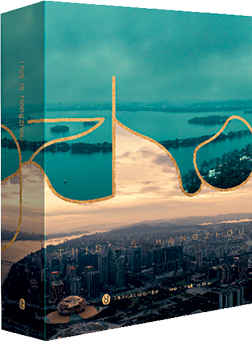
Authors: Chen Huasheng & Chen Fan
Price: RMB 168
Hardcover, 475 pages
Published by Foreign Languages Press and Hangzhou Publishing House
Hangzhou, capital city of east China’s Zhejiang Province and the host city for the 19th Asian Games in 2023, is one of China’s top-tier cities, preceded only by such metropolises as Beijing, Shanghai, Guangzhou, and Shenzhen. Italian explorer Marco Polo (1254-1324), who visited the city in the 13th century, marveled at its prosperity and called it “the most magnificent city in the world.”
This is Hangzhou is about this ancient yet energetic city. The book is divided into six parts: History, Landscape, Art, Famous Cuisine, Craftsmanship and Sports, and Local Heroes.
Part One looks at the history of Hangzhou. The area in north Zhejiang used to be a shallow bay of the Qiantang, one of the largest rivers in southeast China. The tides brought in sediments filling up the bay and forming patches of land. The Chinese idiom Cang Hai Sang Tian (seas change into fields), which means time brings great changes to the world, originated from this phenomenon.
Approximately 4,300 years ago, a great flood swept through the southeastern region. Today’s Yuhang District in Hangzhou is said to be the place where the ancient hero, Yu the Great, tamed the floods by devising a system of irrigation canals that diverted the flood water into the fields. In the olden days, boats and rafts were the main means of transportation south of the Yangtze River and some archaeologists believe the name Hangzhou reflects the water-based culture.
Part Two explores the local landscape of Hangzhou. West Lake, Hangzhou’s beautiful freshwater lake, is renowned for its beautiful scenery, pagodas and surrounding hills, long history, and abundant cultural relics. The West Lake Cultural Landscape of Hangzhou is a UNESCO World Heritage site with innumerable stories.
The Ten Views of West Lake represent 10 exquisite landscapes. Their names are four-character rhythmic words with colorful picturesque elements, such as Su Di Chun Xiao (Spring Dawn at Su Causeway), Qu Yuan Feng He (Lotus in the Breeze at Crooked Courtyard), Ping Hu Qiu Yue (Autumn Moon over Calm Lake), and Duan Qiao Can Xue (Melting Snow on a Broken Bridge). The 10 names are arranged in the sequence of the four seasons first – spring, summer, autumn and winter – followed by the order of flowers, birds, fishes, and insects.
Part Three discusses the art of Hangzhou. Dwelling in the Fuchun Mountains is a famous landscape painted by Huang Gongwang (1269-1354), the most renowned painter of the 14th century China. The long scroll painting depicts the scenery along the Fuchun River and the changing seasons, encompassing the extraordinary mountains and beautiful rivers spanning about “100 miles from Fuyang to Tonglu.” The scroll also reflects over 70 years of Huang’s life, portraying both the hardships he faced and his optimistic attitude towards life. The philosophy of the painting delves into the essence of life.
Part Four introduces readers to the gastronomical tales of Hangzhou’s most famous dishes. For example, Longjing Shrimp, a dish unique to Hangzhou, delicious yet inexpensive, is a must-try delicacy. “Longjing” is the name of a tea produced in Hangzhou. In the 18th century, Longjing tea was offered as a tribute to Qing emperors. Since the tea is produced only in some specific tea gardens, it is a precious commodity. The leaves are used sparingly for garnishing, yet this small amount gives the dish a special taste, and is said to be the taste of spring in Hangzhou. Other famous local dishes include West Lake Vinegar Fish, the Dingsheng Cake, and Sister Song’s Fish Chowder, all of which have their own enchanting stories.
Part Five tells the stories of ancient crafts and skills, including the art of making bamboo paper, the technique of weaving silk, and the invention of movable-type printing, among others. Papermaking is regarded as one of the Four Great Inventions of ancient China. The Chinese people discovered the technique of papermaking by using materials like tree bark and old cloth as early as the first century AD. Yuan Shu paper, which appeared in Hangzhou in ancient times, was made from bamboo. This kind of bamboo paper quickly gained popularity among scholars when Hangzhou became capital city of the Southern Song Dynasty (1127-1279). In the 11th century, there was another great invention in Hangzhou – the movable-type printing. It was discovered by Bi Sheng, a bookshop engraver in Hangzhou. Prior to his invention, printers had to carve out every page on wooden blocks. If even one or two characters were engraved incorrectly, the entire block had to be discarded. Bi Sheng, instead, carved individual characters into clay which was then fired. He then arranged them in an iron frame for printing.
Part Six presents inspiring stories about the greats in Hangzhou’s history. They include Su Shi, one of China’s great poets and an accomplished local governor; Su Xiaoxiao, a beautiful and talented singer in the 8th century, known as China’s Lady of the Camellias, and Hu Xueyan (1823-1885), a businessman during the late Qing Dynasty who was much admired not only because he was a successful businessman but also due to his philanthropy. Living in an era marked by turmoil and calamity, Hu had a pharmacy that provided free emergency medicines to those who couldn’t afford them. He also procured food from other regions and transported it to Hangzhou for the poor and needy. His actions saved numerous lives in Hangzhou, earning him the profound gratitude of the people. These local heroes and their stories show the humanistic spirit of the city. 
